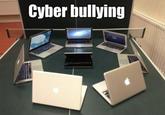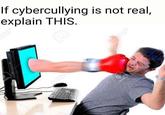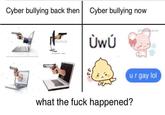Cyberbullying
Part of a series on Internet Slang. [View Related Entries]
[View Related Sub-entries]
About
Cyberbullying is the act of using the internet, social media and related technologies to harass a specific individual or group in a deliberate, repeated and hostile manner. With more people falling victim to cyberbullying every year, a series of legislative efforts and awareness campaigns have arisen to combat the phenomenon.
Origin
Discussion of online harassment and defamation has taken place since as early as 1996, when Canadian lawyers David Potts and Sally Harris presented a paper titled Defamation on the Internet[7] at the Legal Issues on the Internet conference on May 14th, 1996. The term "cyberbullying" was coined by Canadian teacher and public speaker Bill Belsey[1], who launched cyberbullying.ca[3] on March 3rd, 2003 in conjunction with the anti-bullying website he launched three years prior, bullying.org.[4] In an interview with the Huffington Post[5], Belsey explained that he launched the site after bullying.org began receiving stories about students who were being harassed online.

Spread
On March 29th, 2003, The Kingston Whig-Standard newspaper published the first article on Cyberbullying[6], citing the case of a student in Ontario whose classmates created a website to anonymously share hateful messages about him. In May 2004, Macleans Canada published an article[11] about the cyberbullying experienced by Ghyslain Raza after a video of him known as "Star Wars Kid" went viral online. The experience led him to seek counseling while his family launched a lawsuit against those harassing him.

In November 2004, privacy lawyer Parry Aftab[8] launched NetBullies.com.[10] In February 2005, Aftab also launched the first American cyberbullying prevention program, StopCyberbullying.org[9], which encourages victims to step away from the computer, block their harasser and tell an adult about the situation. In April 2005, The Cyberbullying Research Center[12] was created to monitor and track bullying trends in schools. They posted data in 2013 that revealed an average of 23.9% of middle school students had been a victim of online harassment between 2007 and 2011.

On June 27th, 2007, the Pew Internet and American Life Project released their first report on Cyberbullying[13], where they found that 32% of the teenagers polled that went online regularly had been cyberbullied. As reports of suicides caused by cyberbulling began to emerge in late 2007, it began to gain more news media attention, with stories on the phenomenon appearing in the New York Times[18] and on NPR.[19] In May 2008, the first federal law against cyberbullying was proposed to the House by Californian Rep. Linda Sánchez and Missourian Rep. Kenny Hulshof[20], but it did not receive traction.
Related Events
Ryan Halligan's Death
Ryan Halligan, who killed himself on October 7th, 2003, was one of the earliest known suicides attributed to cyberbullying. He was bullied offline beginning in 2000, but in the summer of 2003, the bullying began to take place online, over instant messaging services. After his death, Halligan's father Tony found archived transcripts of these chats, learning his son's classmates had taunted him about being gay. It escalated when a girl he liked pretended to have a crush on him to gain access to his personal information in order to spread it around school. He also found transcripts of chats with an online penpal, in which his son shared information about suicide. In May 2004, Halligan's home state of Vermont enacted a Bullying Prevention Policy Law followed by a Suicide Prevention Law in 2005 with help from Tony Halligan. His story was featured in a January 2008 episode of the national television program Frontline (shown below).
Megan Meier's Death
In October 2006, a 13-year-old girl named Megan Meier[15], committed suicide in her Missouri home. In November 2007, her parents revealed that her death was caused by an act of cyberbullying. Prior to her death, Lori Drew, the mother of one of Megan's friends, had created a fake MySpace profile for a 16-year-old boy named Josh Evans. Evans' account was controlled by Drew, her daughter and a friend, with the intent of gaining personal information from Megan to eventually humiliate her for allegedly spreading rumors about Drew's daughter. After exchanging messages for a month, "Evans" began to insult Megan before telling her "the world would be a better place without you" the evening she died. On May 15th, 2008, Drew was indicted by the United States Grand Jury for four counts violating the Computer Fraud and Abuse Act.

Though Drew was found guilty of a misdemeanor violation of the Act, a United States District Judge overturned the ruling in August 2009.[16] In December 2007, Megan's mother Tina launched the Megan Meier Foundation[18] to bring awareness to cyberbullying and help parents and educators understand these situations. The federal case, along with the work of Tina Meier's foundation, led Missouri lawmakers to pass the first bill relating to online harassment[17], which went into effect on August 28th, 2008.
Jessi Slaughter
Jessi Slaughter is the nickname of Jessica Leonhardt, a Florida teenager who became the subject of a 4chan raid in July 2010 after a member of the now-defunct website StickyDrama accused her of having an illicit relationship with the vocalist of the band Blood on the Dance Floor. She uploaded several YouTube vlogs that were shared on 4chan's /b/ (Random), resulting in harassment across her social networking profiles. The harassment escalated to a point that it affected her family, resulting in a video containing a warning from her late father, where he told the attackers "you done goofed" as he asserted that he would be getting the police involved.
Her father's message backfired, as his mentions of "backtracing" and calling the "cyberpolice" was immediately met with ridicule and parody single serving websites. The police did get involved later that month after the Leonhardt family began receiving death threats.
Tyler Clementi's Death
Tyler Clementi[21] (shown below, left) jumped to his death from the George Washington Bridge between New York and New Jersey on September 22nd, 2010 after his Rutgers University roommate, Dharun Ravi, and hallmate, Molly Wei, streamed an intimate encounter between Clementi and another man online without his knowledge, while broadcasting the news via Twitter (shown below, right). Clementi's death was reported on by dozens of news media both online and in print[22], bringing national attention to cyberbullying, specifically of those in the LGBTQ community. In March 2011, New Jersey Senator Frank Lautenberg introduced the Tyler Clementi Higher Education Anti-Harassment Act[23] to require colleges and universities to have policies addressing discriminatory harassment both online and off. The bill hit similar roadblocks in congress as the one following Megan Meier's death, but was reintroduced in February 2013.


CyberBu//y
Cyberbully, stylized as “Cyberbu//y”, is an ABC Family movie which premiered on July 17th, 2011. Loosely based on Megan Meier's death, it was marketed as part of a campaign to “delete digital drama." The film tells the story of a teenage girl who is bullied online on the fictional social site “Cliquester,” eventually leading to her attempting suicide.

The film quickly became a target for jokes on websites such as 4chan and Tumblr. Specific scenes in the film also grew to become memes on their own. The most notable of these being "Ur a liar lindsay", a melodramatic close up of a computer screen which became the target of a large quantity of photoshopped versions (shown below, left); and "I can't get the cap off", a phrase originating from an overdramatized scene in which the movie’s protagonist, Taylor, fails to open a child-proof bottle as she attempts to commit suicide (shown below, right).
 
|
 |
Amanda Cummings' Death
Amanda Cummings was a teenager who was reported dead after throwing herself in front of a city bus in December 2011. A memorial Facebook page for her, titled "R.I.P. Amanda Cummings", was quickly vandalized with organized offensive comments (shown below, left). This post-mortem harassment lead to news media coverage, anti-cyberbullying petitions (shown below, right), and the sponsoring of a bill by Senator Jeffrey D. Klein that would create harsher penalties for cyberbullies.


Amanda Todd's Death
Amanda Todd was a Canadian teenager who was reported dead in October 2012. A month prior to her suicide, Todd uploaded a video to YouTube in which she revealed the long string of online and offline harassment she had to go through. Her video, along with the news of her suicide, made her death a subject of many conversations online about the issue of cyberbullying. However, the coverage of Todd's suicide also brought forth controversy regarding various other victims of cyberbullying who went by unnoticed when they committed suicide, claiming the large coverage and mourning of Todd's suicide was undeserved (shown below).


Rehtaeh Parsons' Death
Rehtaeh Parsons was a Canadian teenager who committed suicide in April 2013 as a result of harassment caused by the distribution of an illicit photo. Her death was covered by countless media outlets and a Facebook memorial page managed to gain nearly 30,000 likes within four days. However, the four suspects who allegedly gang raped Parsons and took the photo were not prosecuted due to a lack of evidence. This later lead to Anonymous launching the operation #OpJustice4Rehtaeh, calling for Canadian law enforcement officials to resume the investigation while threatening to publicly release the names of the alleged assailants if no further actions were taken.


Ask.fm Related Deaths
Between September 2012 and September 2013, nine suicides were attributed to cyberbullying that took place on Ask.fm[24], a social network in which users can ask each other questions either logged-in or anonymously. Each of these teenagers, between the ages of 12 and 17, had received harassing messages on the website, ranging from insults to outwardly telling them to die. Buzzfeed[25] reported that Ask.fm founder Mark Terebin responded to the first group of deaths in 2012, stating "mass media is knocking on [the] wrong door]," and that it was the other users, and not the site, causing the deceased's problems. By September 2013, however, Ask.fm promised[26] to add more controls to report abuse throughout the site, as well as updating their policies on moderation and registration for new users.

Search Interest
External References
[1] Center for Interactive Learning and Collaboration (via Wayback Machine) – Bullying.org-Bill Belsey
[2] NCAB (via Wayback Machine) – Cyberbullying: A Virtual Menace
[5] Huffington Post – ChangeMaker: The Downside of Criminalizing Cyberbullying
[6] The Kingston Whig-Standard – When Bullying Reaches Into Cyberspace
[7] David Potts and Sally Harris – Defamation on the Internet
[9] StopCyberbullying.org – Home
[10] NetBullies.com (via Wayback Machine) – Home
[11] Macleans.ca – Stalked By a Cyberbully
[13] Pew Internet – Cyberbullying
[14] ABC News – Parents: Cyber Bullying Led to Teen's Suicide
[15] Wikipedia – Suicide of Megan Meier
[16] Wikipedia – United States v. Lori Drew
[17] Los Angeles Times – Missouri passes cyber-bullying bill
[18] New York Times – More Teens Victimized by Cyber-Bullies
[19] NPR – Cyber Bullies Hard to Stop
[20] Cnet – A rallying cry against cyberbullying
[21] Wikipedia – Suicide of Tyler Clementi
[22] Out – Letters to My Brother
[23] Human Rights Campaign – Tyler Clementi Higher Education Anti-Harassment Act
[25] Buzzfeed – 9 Teenage Suicides In The Last Year Were Linked To Cyber-Bullying On Social Network Ask.fm
[26] Business Insider – Users On This Web Site Have Successfully Driven Nine Teenagers To Kill Themselves
[27] Wikipedia – Suicide of Ryan Halligan





















Top Comments
Fenris Lupiq
Sep 17, 2013 at 03:34PM EDT
Garlic Bread
Sep 17, 2013 at 07:53PM EDT